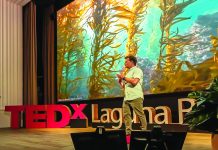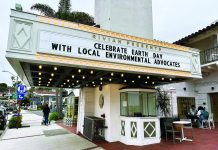Local activists documenting what they say is a lack of security at San Onofre Nuclear Generating Station will present their findings this month to FBI officials who investigate domestic terrorism threats, according to a county official.
Laguna Beach resident and activist Rita Conn, chair of the civic organization Let Laguna Vote, said she took photographs in January and February this year showing unsecured entry to the nuclear power plant, which was forced to stop operating in 2012. The photos show empty guard stations and open entrance gates to the plant, where buildings hold 1,600 metric tons of highly volatile stored nuclear waste.

“I could have gone right in but I didn’t want to risk being at the end of a machine gun, just in case,” she said.
Conn and a committee of local leaders and activists started up the chain of command by taking the photographs and other documents to Orange County’s Fifth District Supervisor Lisa Bartlett and Bartlett’s chief of staff Paul Walters last month. “She was astounded,” said Conn.
At the meeting, however, Conn found there was more work to do. “It was apparent that they were on Edison’s page. I knew we had to turn it around,” she said. Southern California Edison is the utility company that owns the San Onofre power plant.
At the end of the meeting, Walters, a former Santa Ana police chief for 23 years and past member of the FBI’s National Advisory Policy Committee for Los Angeles and Orange counties, arranged another meeting later this month with special agent David Thorp from the FBI’s Orange County office. Thorpe investigates domestic terror threats in Orange County and is on vacation until Aug. 17, Walters said.
“The fact that the FBI is on top of this is as high as we can go with security issues,” Conn said.
“The FBI has to figure out what they can say publicly about what they’re doing to monitor, prevent, apprehend, anything that has to do with terrorism acts,” said Walters, who was also a member of the Orange County Terrorism Task Force. The FBI is determining what information can be publicly released “and not give away any secrets” about how the facility is protected, said Walters, adding that the outcome of the meeting will determine whether a preliminary investigation is warranted.
Accusations pointing to lack of security at the plant “have been completely discredited,” according to SCE media spokesperson Maureen Brown. “We are in 100 percent compliance with all Nuclear Regulatory Commission security regulations,” she said. “Citizen groups, while earnest, sometimes have inaccurate information,” she said. SCE provides electricity to more than 14 million people in a 50,000 square-mile area of central, coastal and Southern California.
Questions about security issues were addressed and resolved during SCE’s San Onofre Community Engagement Panel’s public meetings, held since the plant was closed, Brown said.
The open spent fuel pools, Brown said, are located in monolithic concrete buildings “like containment, and are designed to withstand external events like quakes, tornadoes, etc.” There are 375 employees still at the plant, she said.
The Let Laguna Vote committee organized by Conn includes Gary Headrick, whose San Clemente Green grassroots group initiated the successful push to close the power plant. Other members opposing the storage of nuclear waste at the plant are Laguna Beach Mayor Bob Whalen, activist Audrey Prosser and former city council member Verna Rollinger, Conn said.
The 40-year-old nuclear power plant was permanently shut down two years ago, leaving nuclear waste stockpiled there. Conn’s group is pushing to move the stored waste to a more remote location to decrease the site’s vulnerability as a potential terrorist target and ensure greater safety for surrounding residents and their property, she said.
The used fuel is considered more toxic by activists than the nuclear fuel once generated there due to its concentration of plutonium. The radioactive isotope carries serious health risks and is more dangerous when inhaled than ingested, according to the U.S. Environmental Protection Agency.
Two nuclear steam generators at San Onofre were temporarily shut down in January 2012 after radioactive steam leaked from worn water-transporting tubes inside one of the generators.
Since the Sept. 11 terrorist attacks 14 years ago, the national strategy is to develop prevention, evacuation and response plans for potential terrorist targets, said Walters.
Conn remains critical of SCE’s intended use of an underground storage system for spent fuel that lacks a long-term track record and cannot be moved once in place.
In an April letter to Conn, the Department of Energy stated it is looking at potential storage sites for radioactive fuel waste from decommissioned power plants, according to Peter Lyons, the DOE’s assistant secretary for nuclear energy. “DOE believes that we must solve the issue of nuclear waste disposal, and we must do it in a way that will ensure public trust and confidence in decision-making throughout the process,” wrote Lyons.
“Our concern is to get the stored nuclear energy waste away from a highly populated area,” Conn said. “Until that’s done, we need to make sure the area is as safe as possible. I’m glad they’re in the direction of moving the stuff.”
Southern California Edison’s decommissioning plans call for moving two-thirds of the spent fuel rods currently in “wet” storage to concrete-encased, sealed steel canisters, known as dry-cask storage, said Brown. The rods are now kept in 40-feet of water in steel-lined concrete pools in a monolithic concrete building at San Onofre. There are between 2,600 and 2,700 spent fuel rods that need to be moved, she said.
SEC is looking at “interim” sites to move the fuel, said Brown, either in New Mexico or Texas. “In this regard, we are aligned with both our supporters and our critics,” she said. SCE is not holding much hope for the DOE’s licensing of Yucca Mountain in Nevada as a storage site to come through quickly enough.





There are many technical, political and legal roadblocks to moving the waste, so we cannot count on that happening anytime soon. Therefore, it’s critical the best storage is used while it’s here. Also the fuel must cool for decades before it can be moved.
Edison is planning two major experimental storage systems that need to be stopped. The existing dry storage system and the one Edison plans to procure uses thin steel canisters that can crack in marine and other corrosive environments. The Koeberg nuclear plant had a similar component crack and leak in 17 years. That means San Onofre could have a leaking canister in 5 years. The Koeberg container was about the same thickness as San Onofre canisters and San Onofre canisters began loading in 2003. These canisters cannot be inspected for cracks or repaired. They also have no early warning monitoring system, so we won’t know until after they leak radiation into the environment. Each canister contains more radiation than released at Chernobyl. Look past Edison press releases and PR campaign. Read government and scientific sources at SanOnofreSafety.org. Watch video of Holtec vendor stating these canisters cannot be repaired and that even a microscopic crack will release millions of curies of radiation into the environment.
Also, Edison wants to use air chillers to cool the spent fuel pools. This is the same technology used to cool fish aquariums. This system has never been used for primary cooling of the volume of extremely hot and radioactive fuel stored in San Onofre pools. Even a partial exposure of the fuel in the pools will create a radioactive fire than cannot be extinguished. Edison is requesting the Nuclear Regulatory Commission give them an exemption so they can define this cooling system “non-safety related”.The pool chiller cooling system they are planning does not meet nuclear safety standards. The Coastal Commission needs to reverse last weeks decision and deny the coastal permit. They were given misinformation to base their decision on. Edison was given a chance to rebut my statements at the meeting. But I was not given an opportunity to rebut their misleading statements.
In October, the Coastal Commission will be deciding on whether to grant a permit for the dry storage system. They should reject the permit.
Most of the rest of the world uses thick casks up to 20″ thick that don’t have cracking issues and are transportable and maintainable. The system Edison plans to buy has no NRC approval for transport of the high burnup fuel stored at San Onofre. Read and share this handout “Reasons to buy thick nuclear waste dry storage casks and myths about nuclear waste storage”:
https://sanonofresafety.files.wordpress.com/2011/11/reasonstobuythickcasks2015-04-16.pdf
The CPUC AGAIN did itself yet another dis-service by holding a distant meeting far away from all those affected by the San Onofre Debacle – WHY?
Why is the CPUC so scared that they will not hold multiple meeting in SoCal to really gather a wide verity of public reactions instead of yet another “dog and pony” show where supporters of these Utilities declare how wonderful they are (since the Utilities donate heavily to these same groups with the money they have taken from ratepayers).
The CPUC practice or rewarding interveners that support the CPUC is a sham and the process of paying interveners needs to be changed so that all those that bring information forward get fairly enumerated instead of just those that side with the CPUC like UCAN and TURN.
Until ALJ Darling overturns the entire settlement and recuses herself, she will not only remain part of the problem but will remain tainted by #SanOnofreGate *.
If on the other hand, she does indeed overturn the entire settlement and also recuses herself, then she will be seen as someone that got caught up in the discussions with SCE (who then tried to maneuver her into limiting the “reasonableness” investigation of SCE’s operation of San Onofre) by holding her own ex parte conversations “over her head” if she did not play along with SCE.
Now by hitting back at SCE (by deciding to “sanction” SCE for dubious statements of its executives) she is attempting to distance herself from those that did have ex parte “meetings” versus all those that had ex parte “conversations”. This action will buy her some time in order for her to “see how the dust settles” and she can always later recuse herself if it looks like things are going poorly for her, regarding her “involvement”.
I believe this is just the first of many well calculated maneuvers we will see as all those involved in #SanOnofreGate try their best to sidestep being held in any way responsible for either impeding Justice and/or the “raping” of millions of SoCal ratepayers for anywhere from 3 to 7 BILLION dollars, depending upon what is counted!
The other “wild card” is the ongoing investigation that is being done OUTSIDE of the CPUC, and that investigation may provide the FIRE that sets #SanOnofreGate ablaze, since once it becomes known to the attorney General and others that BOTH ex parte discussions and also ex parte meetings were routinely being held, it will not only inviolate the one sided San Onofre “Settlement” but potentially result in criminal charges being filed.
BTW: SDG&E has until now been trying very hard to stay in the shadows, but I believe that their emails will also be required to be turned over to investigators, which will then show that SDG&E also had ex parte conversations and/or meeting; so they not only knew about these SCE/CPUC meetings but SDG&E was a party to them (in the very least by “daisy chaining”) as they all tried to figure out how to (behind the scenes) best “settle” this investigation in their favor.
*The new hashtag that will allow you to keep up to date on the ongoing investigation into the multi-billion $ SCE-CPUC ripoff.
###
Extra Info:
1. Gov. Brown (a long time friend of Peevey) has to date taken a hands off role regarding San Onofre, other than appointing Peevey’s replacement (since Peevey chose not to seek “reappointment”) who has insured that the CPUC maintains the status quo.
2. Governor Brown’s sister is on the Board of Sempra Energy as are others that are familiar names to many in San Diego. http://www.sempra.com/about/governance/board-of-directors.shtml
3. Peevey’s wife is also an elected CA State Official.
4. Peevey (who is a graduate from UCB) made giving them $5 million a year for a number of years a key component of his San Onofre Settlement Deal. This money will fund Climate Change Research by UCB. I believe that this Research will then be used to justify Utility Energy Production instead of Residential Energy Production, much like Big Milk and/or Big Meat funds Research to then justify the consumption of ever more Milk and Meat in our diets because it has been shown to be healthful in University scientific studies.
5. SDG&E which is owned by Sempra Energy, has done a great job of staying out of the public spotlight regarding San Onofre Gate despite being a 20% Owner of San Onofre. SDG&E had to have knowledge of all Utility settlement discussions before agreeing to any settlement as proposed by the CPUC. Look for Freedom of Information (FOI) requests being filed with SDG&E in order to find out how much they knew, who knew it and when they knew it as San Onofre Gate expands.
6. US Senator Boxer received notarized documents regarding the replacement steam generators (RSG) Design Problems long before she started asking the NRC pointed questions about the replacement steam generators in Public, despite being the Chair of the US Committee on Environmental and Public Works, which has oversight of the NRC.
7. Since SoCal ratepayers will EACH be liable for about $1500 per Utility account if the CPUC “settlement” stands, expect the rate paying public to increase its demand for more information, regarding anything that might reduce or better yet transfer that $5 billion dollar debt to the Utility shareholders, which is why #sanonofregate * will continue to grow.
Rita Conn should be applauded for her intrepid citizen investigation of the lack of security at SONGS. Kudos to The Indy for publishing this excellent and detailed article.
That’s the good news. The bad news is neither local activists, SCE or even the FBI seem to have wrapped their heads around much more serious security vulnerabilities at the plant, ones EnviroReporter.com exposed in October 2013. The four-part series Black Swan SONGS at http://www.enviroreporter.com/2013/10/black-swan-songs/ spells out the problem and provides the solutions, all of which have been ignored by folks, employees and government officials near the plant.
Dismiss this information at your own peril. SONGS is a potential dirty bomb prepositioned for use by terrorists a lot more imaginative and driven than the people in and around the closed reactor complex.
The FBI’s special agent David Thorp from the FBI’s Orange County office may be the area’s last chance to address this life or death issue. He now knows where to find us should he care to discuss these bigger challenges.
There are some errors with the headline.
“biased individual makes unsubstantiated claims : fails to breech nuclear facility”
There, FIFY
CGNP.org
[…] Conn, organizer of the advocacy group Let Laguna Vote, voiced her objections to the type of canisters […]
[…] Conn, organizer of the advocacy group Let Laguna Vote, voiced her objections to the type of canisters […]
[…] As for San Onofre, Rohrabacher, who serves on the House Committee on Science and Technology, acknowledged that while […]
[…] nuclear power plant, to extract the stored waste and move it elsewhere, according to Rita Conn, organizer of the presentation and chairperson of Let Laguna […]